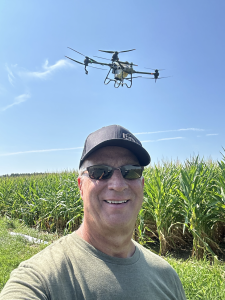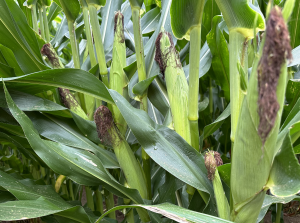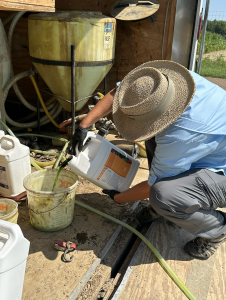Look up in the sky: it’s a bird, it’s a plane, it’s… a drone? This weekend I flyover fed my corn using a Rantizo drone. My corn has well exceeded the height of the ground rig, and airplane application is not an option. Since I wanted to feed and protect the crop at its present R3 stage, a drone was the only option.
Drones are becoming popular tools for farmers and ag retailers. They’ve served as a convenient, labor-saving eye-in-the-sky for farmers and ranchers to scout crops, collect real-time data and check fence lines, irrigation and livestock watering equipment. According to a Farmakis Media study, farmers named drones as by far the best new product/technology they planned to try in 2024. The ag drone market, already at $3.6 billion, is expected to nearly double by decade’s end. And now, drones are being used to apply crop inputs. According to a Crop Life survey among ag retailers, the use of drones for application work stood at 14% in 2021, rose to 32% in 2023, and is projected to jump to 54% by 2025. The guys who sprayed my corn, Rantizo, told me much of their treated acreage is in areas that “pilots won’t touch,” such as spraying herbicides that tend to cause off-target drift. The first thing you notice with these drones is the spray stays where they put it; there was no noticeable drift. And there was no spray boom on the model they used. The drone used two atomized nozzles, and the propellers blew the spray mist directly into the crop foliage. The drone hovered about 8 feet above the tassels, to optimize spray pattern, as it sprayed a 25-ft swath. It could treat about two acres before requiring a stop for refills and battery changeovers (batteries recharged in the time it took the drone to make its next two-acre pass). While the tank held 20 gallons, we filled it to 10 gallons. There’s still a weight-volume balance required for optimizing battery efficiency. Then there’s the cost. Drone application cost is still well above that of airplanes. These factors currently make broad acreage difficult to justify beyond niche uses. But as more farmers purchase their own units, and technology advances, the future of drones spraying appears to be sky high.

This weekend’s drone application is likely my final pass of the season. I had two goals for the flyover. First, I wanted some crop protection insurance. A few years ago, I experienced Southern Rust (remember my post a few weeks ago about how farmers have long memories). I wanted to prevent that from impacting the health of my crop, so we applied Crop Gard and Proud 3. Second, I want to produce big kernels. Based on my experience with the corn hybrid I’m growing, AgriGold 6659, I’ve seen that it has the genetic potential to produce excellent deep kernel depth and heavy kernels on its long ears. Three years ago, we described the ears of 6659 as baseball bats. I want that again. To add more kernel size, we applied Golden Pro. But adding weight also requires plants to remain green and healthy longer into the reproductive stages, so we added Max Pak, X-Tend and Super Nitro. The foliar nitrogen should also stimulate the roots to pull additional soil nutrients into the plant. The one nutrient we’ll continue to add is water. We’re still experiencing dry weather, and temperatures are expected to climb into the upper 90s this week. I plan to irrigate today, and as long as needed.


Related Posts

This Week in Ag #16
If the TV show MythBusters ever did a program on farming, there are several common myths about farmers they could bust.

This Week in Ag #22
Twenty years ago, I found myself in the position of operating a farm all by myself. My father, who I was farming with, passed away suddenly that January. So in addition to my full-time ag marketing job, I was flying solo across my family farm in western Illinois.

This Week in Ag #45
“Life.” That was my response when asked “What does soil health mean?” during an interview on The Big Show with WHO Radio last week. Whether it’s accelerating populations of soil microbes and worms, creating diverse biological communities or building biomass and aggregates, healthy soils are full of life. The trick is to stimulate and maintain biology in

